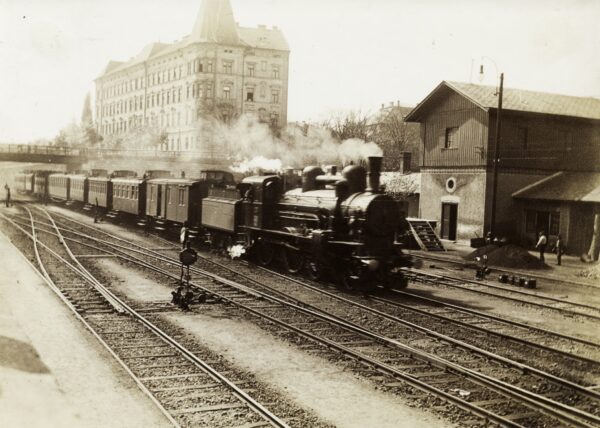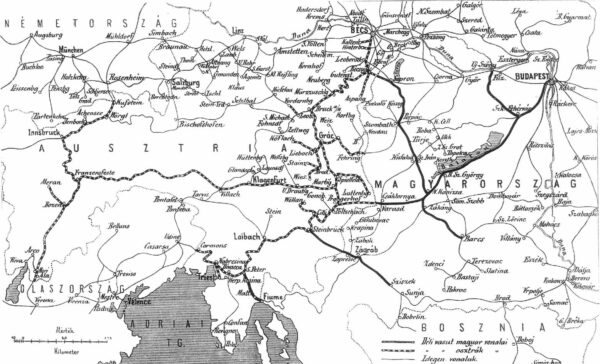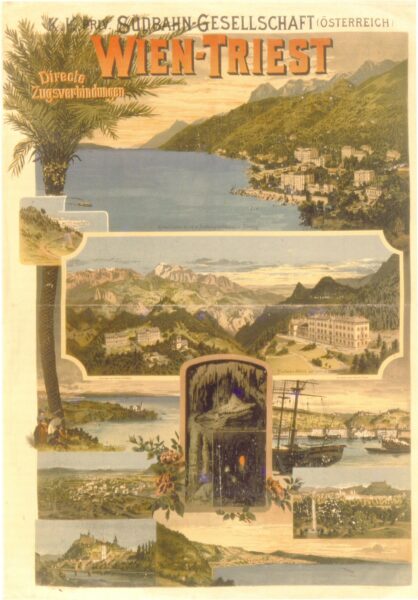Southern Railway

Although the Austrian railway network was conceived as a state railway, the financial crisis of 1854 led to the state railways being privatised and the government subsidising private railways.
The basis of the Southern Railway is the Cs. and Kir. The Southern State Railway, which also built and operated the Vienna-Trieste railway. This company and several other railway companies, such as the Cs. K. szab. (The merger of the two companies, the KFJOB (KFJOB), founded in 1857 by Emperor Franz Joseph, and the Lombard-Valenese and Central-Italian Railway Company, was merged with French and English capital to form the new joint-stock company on 1 January 1859.) The merger of the KFJOB, originally founded mainly by Hungarian investors, was strongly criticised by the Hungarian side, including István Széchenyi.
The network then included existing rail lines in Hungary, Austria and northern Italy, as well as many projects under construction. At that time, the Southern Railway had 1396 kilometres of lines built, 1105 kilometres of lines under construction and a further 632 kilometres of lines under planning.
The company organised its traffic and liner network around Austrian economic interests, as it linked these areas to the empire's maritime trading gateway, Trieste. In the early years, the Southern Railway was received with hostility in Hungary, despite the fact that it had a significant, unified network in the Danube region and that it provided important Hungarian rail links, since it was the network that provided access to the Hungarian seaport of Rijeka from 1873.
The Austrian sections of the line were decisively influenced by the process of Italian unification, as the unified Italian state was formed shortly after the creation of the company, and from 1866 onwards further territories formerly belonging to the Austrian Empire were added to Italy. First, therefore, the Italian and Austro-Hungarian operations were separated, and after 1867 negotiations were opened on the railways in these areas. First a separate Italian board was set up, and then in 1876 the 2,076 kilometres of the Italian network were sold to the Italian state, which led to a reorganisation of the company and a change of name.

The connection between the Austrian and the Hungarian sections was regularised in 1880, as the Southern Railway's tax exemption expired in 1880. Negotiations were therefore started with the Hungarian government on the situation of the Hungarian lines, as a result of which the Hungarian state redeemed the Zagreb-Károlyváros line for MÁV in exchange for an annuity of HUF 240 000 until the expiry of the Southern Railway's patent in 1968. In Budapest, the company first had limited, then from 1896 extended, powers, but organised a separate directorate of operations, and the language of the railway on Hungarian sections became Hungarian.
The main lines of the Hungarian network were the Buda-Trieste and the Vienna Nagykanizsa lines, but the Komárom-Székesfehérvár line was also important. Buda's first railway station, the Déli Railway Station, was opened in 1861 under the management of the Déli Railway. In addition, the Déli Vasút undertook in the 1880 contract to establish and maintain HÉV lines.
The end of the Southern Railway came after Trianon, when the lines were administered by four countries. The 'Treaty of Rome' of 29 March 1923, concluded to regulate the four sections, agreed on the operation and division of the rolling stock (to the disadvantage of Hungary, partly because it legalised the assets requisitioned by the Italians in 1918). The company was divided into four parts and the successor states were given the right to redeem the network of lines on their territory. The company then took the name of Drava-Sava-Adriatic Railway (DSA). In the 1920s, the other states outside Hungary redeemed their lines one by one, leaving only Hungary with a total of 560 kilometres of lines. Although DSA started major modernisation work on the Hungarian lines, the plans were shattered by the economic crisis, the company collapsed and the company was taken over by MÁV on 1 July 1932, although the ownership of the company was not settled until the 1960s, when the Austrian-Hungarian property law was negotiated.

Points of interest
It is thanks to the Southern Railway that Lake Balaton is as it is today. When the railway line along the lake was planned (by the predecessor company KFJOB in 1857), the lake experienced a long period of drought, which caused the water level to be low, but the planners took this water level as a constant. Although local residents and experts warned the surveyors through the press that the water level could be much higher, this was not accepted. In the winter of 1861-1862, however, high water levels and ice threatened rail traffic. The solution was not to rebuild the railway line, but to regulate Lake Balaton, which resulted in the current water level and shape of the lake.
The Southern Railway had one of its central repair bases and main workshops in Marburg (now Maribor, Slovenia), the first workplace of Joszip Broz, who later became dictator of Yugoslavia under the name Joszip Tito.
Sources
- Tamás Nagy: A Short History of the Southern Railway in BELVEDERE 95/V11. 3-4.
- Pallas Big Dictionary Southern Railway
- Mihály Kubinszky:Once upon a time there was a Southern Railway Hungarian Review, 2001/7-8 issue
- Hungarian Railway History 1 (Editor-in-Chief Dr. László Kovács) MÁV, Budapest, 1995
Founded on 1 January 1859.
Date of cessation: 1932
Founders: the Rothschild banking house
Securities issued:
| Southern Railway |
| Southern Railway Futures |
Main activity: railway operation
Author: by Domonkos Csaba
Founded on 1 January 1859.
Founders: the Rothschild banking house
Determinant drivers are not set
Main activity: railway operation
Main products are not set
Seats are not configured
Locations are not set
Main milestones are not set
Author: by Domonkos Csaba
Southern Railway

Although the Austrian railway network was conceived as a state railway, the financial crisis of 1854 led to the state railways being privatised and the government subsidising private railways.
The basis of the Southern Railway is the Cs. and Kir. The Southern State Railway, which also built and operated the Vienna-Trieste railway. This company and several other railway companies, such as the Cs. K. szab. (The merger of the two companies, the KFJOB (KFJOB), founded in 1857 by Emperor Franz Joseph, and the Lombard-Valenese and Central-Italian Railway Company, was merged with French and English capital to form the new joint-stock company on 1 January 1859.) The merger of the KFJOB, originally founded mainly by Hungarian investors, was strongly criticised by the Hungarian side, including István Széchenyi.
The network then included existing rail lines in Hungary, Austria and northern Italy, as well as many projects under construction. At that time, the Southern Railway had 1396 kilometres of lines built, 1105 kilometres of lines under construction and a further 632 kilometres of lines under planning.
The company organised its traffic and liner network around Austrian economic interests, as it linked these areas to the empire's maritime trading gateway, Trieste. In the early years, the Southern Railway was received with hostility in Hungary, despite the fact that it had a significant, unified network in the Danube region and that it provided important Hungarian rail links, since it was the network that provided access to the Hungarian seaport of Rijeka from 1873.
The Austrian sections of the line were decisively influenced by the process of Italian unification, as the unified Italian state was formed shortly after the creation of the company, and from 1866 onwards further territories formerly belonging to the Austrian Empire were added to Italy. First, therefore, the Italian and Austro-Hungarian operations were separated, and after 1867 negotiations were opened on the railways in these areas. First a separate Italian board was set up, and then in 1876 the 2,076 kilometres of the Italian network were sold to the Italian state, which led to a reorganisation of the company and a change of name.

The connection between the Austrian and the Hungarian sections was regularised in 1880, as the Southern Railway's tax exemption expired in 1880. Negotiations were therefore started with the Hungarian government on the situation of the Hungarian lines, as a result of which the Hungarian state redeemed the Zagreb-Károlyváros line for MÁV in exchange for an annuity of HUF 240 000 until the expiry of the Southern Railway's patent in 1968. In Budapest, the company first had limited, then from 1896 extended, powers, but organised a separate directorate of operations, and the language of the railway on Hungarian sections became Hungarian.
The main lines of the Hungarian network were the Buda-Trieste and the Vienna Nagykanizsa lines, but the Komárom-Székesfehérvár line was also important. Buda's first railway station, the Déli Railway Station, was opened in 1861 under the management of the Déli Railway. In addition, the Déli Vasút undertook in the 1880 contract to establish and maintain HÉV lines.
The end of the Southern Railway came after Trianon, when the lines were administered by four countries. The 'Treaty of Rome' of 29 March 1923, concluded to regulate the four sections, agreed on the operation and division of the rolling stock (to the disadvantage of Hungary, partly because it legalised the assets requisitioned by the Italians in 1918). The company was divided into four parts and the successor states were given the right to redeem the network of lines on their territory. The company then took the name of Drava-Sava-Adriatic Railway (DSA). In the 1920s, the other states outside Hungary redeemed their lines one by one, leaving only Hungary with a total of 560 kilometres of lines. Although DSA started major modernisation work on the Hungarian lines, the plans were shattered by the economic crisis, the company collapsed and the company was taken over by MÁV on 1 July 1932, although the ownership of the company was not settled until the 1960s, when the Austrian-Hungarian property law was negotiated.

Points of interest
It is thanks to the Southern Railway that Lake Balaton is as it is today. When the railway line along the lake was planned (by the predecessor company KFJOB in 1857), the lake experienced a long period of drought, which caused the water level to be low, but the planners took this water level as a constant. Although local residents and experts warned the surveyors through the press that the water level could be much higher, this was not accepted. In the winter of 1861-1862, however, high water levels and ice threatened rail traffic. The solution was not to rebuild the railway line, but to regulate Lake Balaton, which resulted in the current water level and shape of the lake.
The Southern Railway had one of its central repair bases and main workshops in Marburg (now Maribor, Slovenia), the first workplace of Joszip Broz, who later became dictator of Yugoslavia under the name Joszip Tito.
Sources
- Tamás Nagy: A Short History of the Southern Railway in BELVEDERE 95/V11. 3-4.
- Pallas Big Dictionary Southern Railway
- Mihály Kubinszky:Once upon a time there was a Southern Railway Hungarian Review, 2001/7-8 issue
- Hungarian Railway History 1 (Editor-in-Chief Dr. László Kovács) MÁV, Budapest, 1995